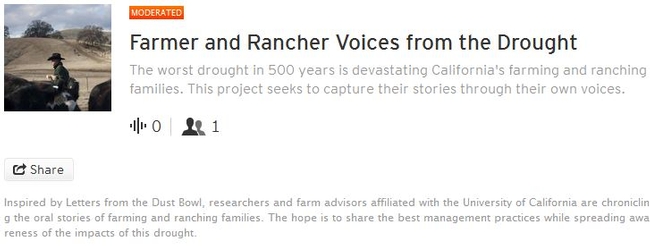Water sloshes from a fill hole atop the steel tank and strikes the dirt road in puffs of dust. With weathered hands, short nails and a once black felt cowboy hat, Adam Cline motors the water truck through the anxious herd. Piled on the floor beside him are several 40 pound bags of soybean meal, a more affordable protein supplement that protects the herd from malnourishment. Cline is fortunate: his cautious management strategies over the last two years will likely carry this operation through yet another drought year, without having to sell off any cows.
“Every rancher is equipped for an average drought,” he tells me. “But a drought like this is really hard to manage for… Emotionally it's like a battle every day to try to figure out how you can afford to feed your cows, how you're going to get water to them.”
Letters from the Dust Bowl
With as little as a quarter of the average rain in 2013, the drought in this region has now entered its third year, breaking records on a regular basis. And it may be the worst here in 500 years. Many of the University of California researchers and farm advisors helping the state's agriculture industry prepare for the coming dry summer months are comparing the water shortage to the historic Dust Bowl of the 1930s, when many Oklahoma farmers and ranchers left their homes in hopes of a better life in California. In her "Letters from the Dust Bowl," Caroline Henderson captured the voices of agriculture's most difficult era in America.
In honor of Henderson's work, a team of UC researchers is developing a project that will use digital tools to capture the voices of the farming and ranching families who are today battling the worst drought they have witnessed. On one front, the project, called Farmer and Rancher Voices from the Drought, is cultivating a following through a new Facebook group. Later print and multimedia stories will be added to a UC Davis drought page.
Today, however, we are launching a new audio component, where farmers and ranchers are interviewed and recorded by a friend, colleague or loved one. They document their stories of the drought, explaining what practices have worked for them so that others dealing with these struggles can better cope. Through the broad 100-year Cooperative Extension effort at the University of California, faculty, staff and researchers are reaching out to the extensive network of farming and ranching families across the state, encouraging each of them to share their stories.
How the 'Voices' project works
The audio component of the project is hosted on SoundCloud, where anyone can easily record and upload an audio track to share. Our team is moderating the SoundCloud group and approving each recording. The tracks will be shared across our social media and web pages, where they will hopefully gain the attention of media, as well as the general public.
Here are a few guidelines to smooth the process:
- Create an account. Recording is easy, but first you must go to the SoundCloud site and sign up. You can also download and record with their smart phone app.
- Research your strategy. StoryCorps, a nonprofit project, has an excellent instruction guide for helping you record your interview. While you're there, we encourage you to also upload your finished story to the StoryCorps DIY page, where it will be preserved at the Library of Congress.
- Keep it short. By limiting your recording to three minutes, your story will keep listeners interested while maintaining its most essential parts.
- Frame your conversation around questions. Have your interviewer select from this list and add follow-ups:
- Provide your name, what you do and some background information on your farming or ranching operation.
- How has your operation been affected by the drought?
- What have been your management practices in response?
- What will you do differently if it continues?
- Is this the worst drought year you've experienced?
- What are your stocking and supplemental feed rates? Or how much land is planted versus fallow? Explain.
- What will your operation look like next year if the drought continues?
- How has this affected you and your family?
- What advice would you give others in similar situations?
- What should those outside California know about this drought?
- Finally, name it. Once you have successfully loaded your conversation onto our SoundCloud group, let us know more about yourself. Send us your feedback and some details so we can follow up: an email address or phone number, the storyteller's name, the interviewer's name, the company name (if you're affiliated with an agricultural organization) and a photo.

